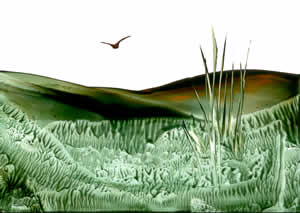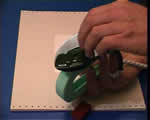 |
With the iron set to the normal LOW working temperature, load the area
shown here with  .
If you are left handed then swap the iron into your left hand and load it
correspondingly. .
If you are left handed then swap the iron into your left hand and load it
correspondingly. |
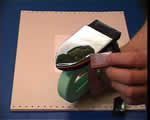 |
Next, carefully and slowly add a line of  along
the edge of the curved part of the iron. along
the edge of the curved part of the iron.

|
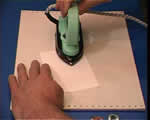 |
Position the iron on the card so that the waxed area sits onto the card
surface and not on the disposable underpaper. Hold the painting card
at the top so that your hand is out of the way, then start to slide the
iron lightly across the card. |
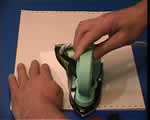 |
... until you reach the opposite edge of the card.
NOTE: Make sure that the horizon
line reaches right across from one edge to the other in a hard and clean
line. A common fault is to stop as soon as the iron reaches the edge of
the card, but the wax is no longer at the iron's tip, so you need to move
the iron over the edge of the card and onto the under[paper until you
can see that firm horizon line ALL THE WAY ACROSS

|
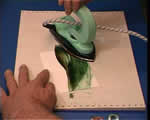 |
Once that is done just reverse the iron's direction and smooth back
over the lower area of the card, dragging and spreading the wax colour
as you go. |
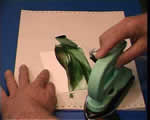 |
When this application of the wax is complete there should be a reasonable
coating all over the lower section of the card. If there is not much
wax towards the bottom you can always re-wax the iron and apply a bit more
over the original colour. |
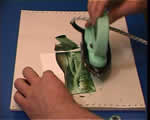 |
Keeping the card flat, place the iron down onto the lower third of
the surface and lift from the top edge first - just like opening a box
with the hinges at the bottom edge of the iron. |
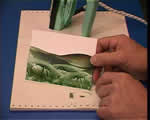 |
Now you can see the foliage effect caused by suction between the
iron and card creating air channels in the wax as it lifts away and breaks
the suction.
However, the disadvantage here is that the iron's edge has created
marks from its edge that resemble arcs and make the foreground less
realistic than it might have been if these were not present.
|
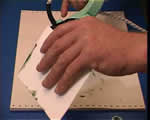 |
Hand Held Dabbing for Foliage Effects
There is a solution to this "Arc Mark" problem.
- Hold the card in your free hand with your fingers behind to give support
|
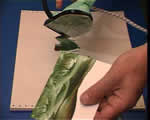 |
- Your thumb should NOT press down hard onto the front surface because
it will kink the card and cause a problem.
|
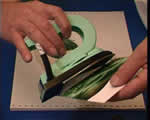 |
- Gently place the iron's base close to the card and allow it to touch
at the bottom edge
- Then use your fingers behind and the iron in front to gently but firmly
"spring" the card and iron surfaces together and then immediately
apart again, but WITHOUT THE TOP EDGE OF THE IRON TOUCHING
|
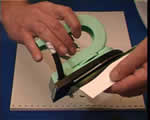 |
If the top edge of the iron touches then you will still get the arc marks
so take care to ensure that top edge does not touch the waxed card. |
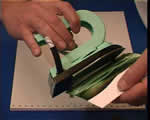 |
Repeat this technique of springing the iron face and card together and
apart - almost bouncing the iron off the card! |
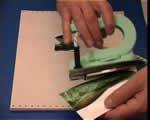 |
Remember to move your fingers around behind the card to correspond with
the area that you are pressing onto at the front with the iron. So long
as you spring the iron on and off without a pause then the card will not
allow sufficient heat through to burn your fingers. Just take care not to
hesitate for too long! |
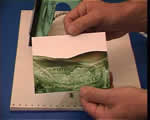 |
After the hand held dabbing is completed your foreground should look a
more natural collection of seemingly random foliage effect. |
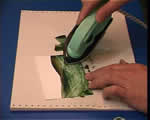 |
Creating Grasses by sliding the iron's edge
Now for the grasses. Turn the iron's handle inward towards your free
hand to a 45 degree angle and rest the curved edge onto the lower part
of the card (your foreground).
|
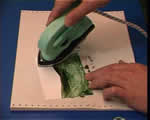 |
Gently but firmly slide through the wax colour, remelting it with the
iron's edge as you go and thus forming a sharp line behind. This cutting
motion is similar to that of an ice skate cutting through ice - it wants
to go straight ahead, but beware - PRESSING TOO HARD will cause the iron's
edge to skid sideways, more like a snow plough, and this will create thick
and clumsy lines. |
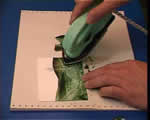 |
Repeat this motion until you are happy with the number of grasses in the
image. |
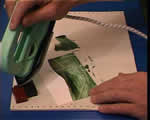 |
Making the Bird
Dip the tip of the iron briefly into both blocks of wax colour - first
the  then the
then the  so get a small drop of molten colour on the end.
so get a small drop of molten colour on the end.
|
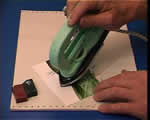 |
Next, touch the tip onto the card in a firm and committed action, so that
the wax forms a small spot on the card surface which will become the center
of the bird. |
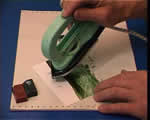 |
Now clean the tip of the iron with some tissue to remove excess wax and
then place the tip back onto the spot of wax and flick it out to the right,
forming one wing as you do so. |
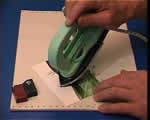 |
Place the iron's tip back onto the central spot or body of the bird and
repeat the flick but this time working out to the left... |
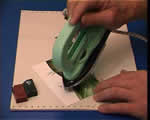 |
... until you have achieved the bird form.

|
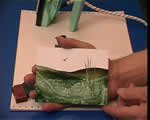 |
So in this image you can practice all four main types of iron stroke
actions - smoothing, lifting or dabbing, edge sliding and point or tip
detailing.
Once this is mastered you have a good basic ability with the iron and
you can then progress onto skies to elaborate the images further.
|










